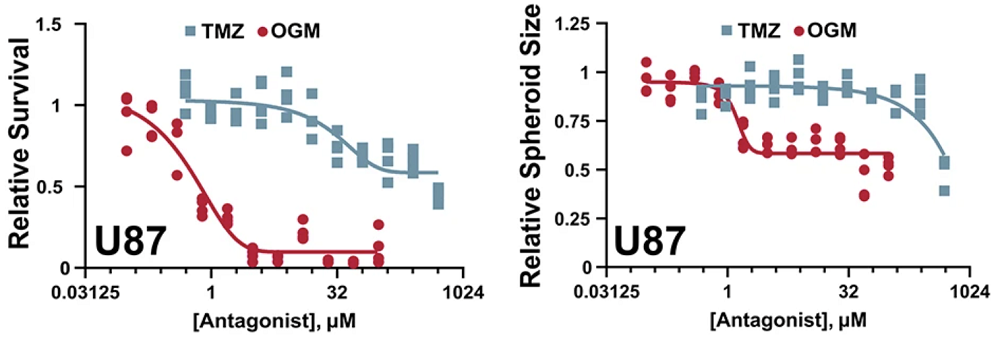Scientists have discovered a small molecule that effectively kills glioblastoma, a highly aggressive and untreatable brain cancer, in cellular cultures [1].
When acidic means deadly
Despite scientists’ best efforts, some types of cancer remain almost as deadly as ever. This includes the dreaded glioblastoma, a type of brain cancer that is especially aggressive and resistant to known therapies [2]. Every year, about 300,000 cases of glioblastoma are diagnosed worldwide, and for the vast majority of patients, this means a death sentence, with the median survival time for adults being less than 15 months (children fare slightly better).
A new study by a group of scientists from Michigan State University might represent a much-needed breakthrough. The authors used the fact that a highly acidic tumor environment is a hallmark of glioblastoma. This acidity is a result of aerobic glycolysis, also known as the Warburg effect. Normally, glycolysis only happens when oxygen levels are low, but cancer cells switch to this less efficient energy production pathway even in normal conditions because it provides them with important survival benefits.
The acidity of the tumor microenvironments correlates with resistance to radiation therapy [3] and the abundance of a receptor called GPR68 on the surface of cancer cells. Additionally, the popular anti-anxiety drug Lorazepam (but not similar medications) has been linked to a substantially increased risk of several cancers and to worse prognoses. Lorazepam has the side effect of being a GPR68 agonist.
Finding a molecule in a haystack
The researchers employed an interesting strategy to screen for compounds that inhibit GPR68. Since embryonic development bears some resemblance to cancer, they looked for small molecules that can disrupt embryonic development of zebrafish in particular ways. They soon turned their attention to a molecule with the nearly unpronounceable chemical name of 5-ethyl-5’-(1-naphthyl)-3’H-spiro [indole-3,2’- [1, 3, 4]thiadiazole]-2-one. This molecule is also known as ogremorphin-1 (OGM). It turned out that OGM is a potent GPR68 inhibitor, which is also how it affected zebrafish development.
The researchers then began working on glioblastoma cells, both in 2D culture and assembled into 3D spheroids that resemble tumors in various ways, including increased acidity. They found that GPR68 probably promotes tumor growth and survival by “notifying” the cell about the increased acidity of the extracellular tumor microenvironment.
The natural-born glioblastoma killer
OGM treatment decreased the viability of glioblastoma cells almost to zero in 2D culture and substantially reduced the size of 3D spheroids. This happened again and again in every glioblastoma cell line that the researchers threw at the new molecule, which had no effects on non-cancerous cells. OGM performed much better than temozolomide (TMZ), the current first-line therapy for glioblastoma. Moreover, the researchers found signs of possible synergy between the two drugs.

To confirm that OGM worked by inhibiting GPR68, the researchers knocked down this receptor in glioblastoma cells using short interfering RNA. The knockdown indeed recapitulated the effects of the drug.
Since with time, immortal cancer cell lines can lose some of their similarity with actual tumors, the researchers repeated their experiments on patient-derived xenografts. OGM was just as effective in all six of the patient-derived cell lines. Finally, the researchers delved into the specific mechanisms of OGM-induced cell death and found that the molecule induces ferroptosis, a specific type of cell death mediated by iron.
Possible effectiveness in other cancers
The study’s authors expect that OGM1 will be found effective in other types of cancer that are also characterized by a highly acidified tumor microenvironment. “Because glioblastoma cells acidify their tumor environment and then use the acid-sensing receptor to survive, the OGM compound essentially cuts off their lifeline,” Charles Hong, the chair of the Department of Medicine at MSU College of Human Medicine and the study’s lead author, explained. “We haven’t found a single brain cancer cell line that it can’t kill.”
Hong called the molecule his team had discovered “an early but extremely promising path to a cure.” The “early” part is true: there is a long way from in vitro experiments to the clinic, but this study’s results are nevertheless hope-inspiring.
We report the identification of a novel class of small molecules, which we named ogremorphins (OGMs), that specifically antagonize GPR68, an extracellular proton-sensing GPCR. Using this drug class and genetic means, we demonstrate that GPR68 mediates a critical pro-survival pathway activated in glioblastoma cells in an autocrine manner by the acidic extracellular milieu.
Literature
[1] Williams, C. H., Neitzel, L. R., Cornell, J., Rea, S., Mills, I., Silver, M. S., … & Hong, C. C. (2024). GPR68-ATF4 signaling is a novel prosurvival pathway in glioblastoma activated by acidic extracellular microenvironment. Experimental Hematology & Oncology, 13(1), 13.
[2] Kleihues, P., & Sobin, L. H. (2000). World Health Organization classification of tumors. Cancer, 88(12), 2887-2887.
[3] Bogdanov, A., Bogdanov, A., Chubenko, V., Volkov, N., Moiseenko, F., & Moiseyenko, V. (2022). Tumor acidity: From hallmark of cancer to target of treatment. Frontiers in Oncology, 12, 979154.
View the article at lifespan.io









































